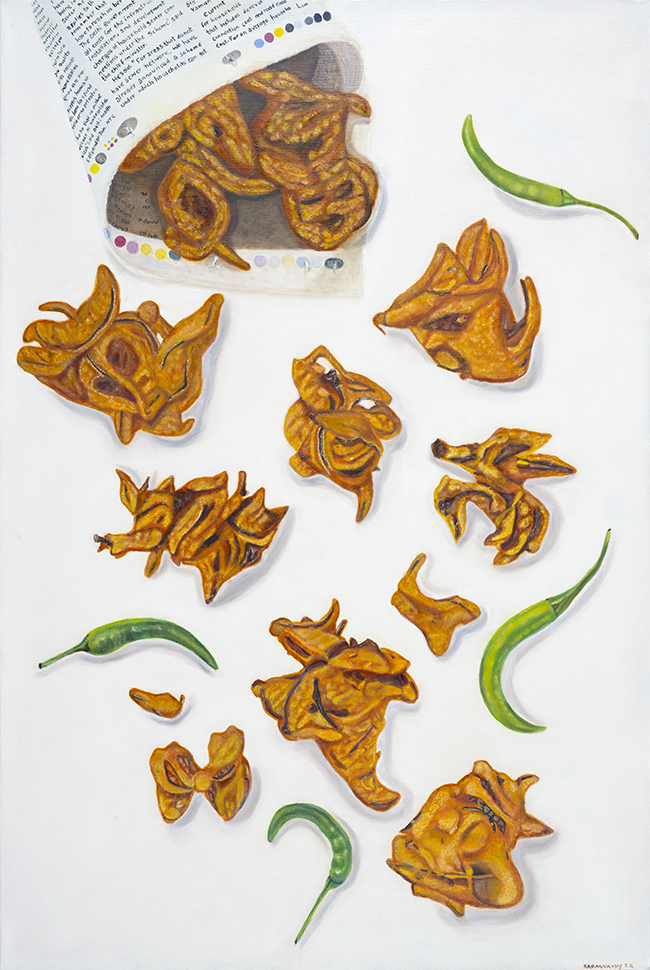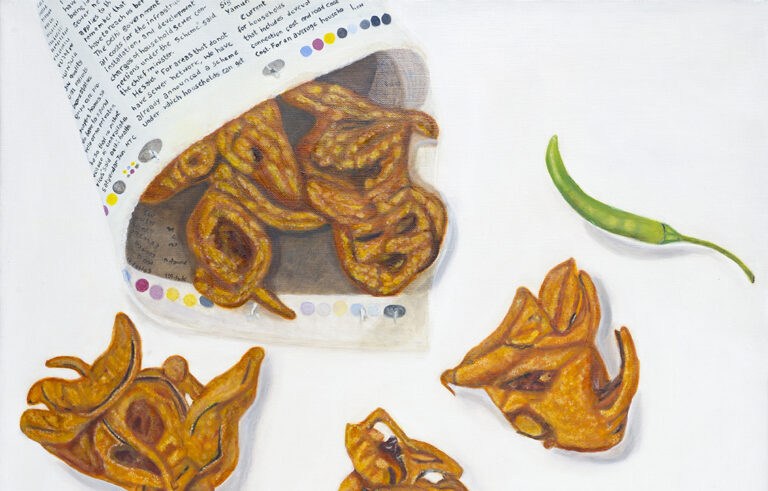In the heart of New Jersey, Sarasvathy TK is a hyperrealistic artist with her oil paintings. Her canvases are not just displays of artistic talent but are vivid narratives that connect deeply with her audience, particularly those with a taste for Indian cuisine. With a brush and a keen eye for detail, Sarasvathy crafts pieces that are not just seen but experienced, enveloping viewers in the rich sensory delights of culinary art.

Sarasvathy’s journey as an artist is as rich and complex as the subjects she paints. Inspired by the Dutch masters of the Baroque period, she has a particular fascination with magnifying and exploring everyday subjects to monumental proportions. This fascination finds its most expressive form in her depictions of Indian food, a central theme that serves not only as a subject but as a muse.
One of Sarasvathy TK’s celebrated works is her painting titled Onion Pakora, a stunning 24” x 36” oil on linen piece that embodies the essence of her artistic philosophy. This painting is a brilliant example of her ability to transform a simple, everyday subject into a work of art that transcends its ordinary context.
Onion Pakora captures the iconic scene of freshly fried onion pakoras wrapped in a newspaper, a sight familiar to anyone who has experienced the joy of Indian street food. The attention to detail in this piece is remarkable, with each pakora depicted in such a way that you can almost hear the crunch of the golden, crispy batter as you look at it. The tangled onion strands within the batter are rendered with a precision that brings them to life, making the pakoras appear irresistibly crunchy and appetizing.
The use of oil as a medium enhances the rich, lifelike colors and textures of the pakoras, making them almost tangible. The golden hue of the batter contrasts beautifully with the deep browns of the fried onions inside, creating a visual feast that is as satisfying to the eyes as the real thing would be to the taste buds. The slight sheen on the surface of the pakoras suggests the lingering warmth of the freshly fried snack, adding another layer of realism to the piece.
The newspaper wrap, often an overlooked element in everyday life, is given the same detailed attention. Sarasvathy captures the slightly crinkled texture of the paper, the faint ink smudges, and the uneven folds that give it an authentic, lived-in look. This detail not only adds to the realism of the scene but also evokes a sense of nostalgia for the traditional way these snacks are often served, wrapped in the day’s news. The newspaper serves as more than just a background; it is a connection to the cultural essence of street food, where the wrap is as much a part of the experience as the food itself.
Accompanying the pakoras in the painting are a few vibrant green chillies, which provide a striking contrast to the warm tones of the pakoras. The chillies, with their glossy, smooth surface, are rendered with the same hyperrealistic precision, making them appear fresh and full of flavor. Their placement in the composition adds a burst of color and hints at the spicy kick they offer, completing the sensory experience that the painting aims to evoke.
What makes Onion Pakora more than just a still life is Sarasvathy’s ability to capture the cultural essence and nostalgic charm of enjoying street food. The painting invites viewers to not just see, but to experience the sensory delight and comfort associated with this beloved Indian snack. It is a celebration of culinary artistry, elevating the simple act of eating pakoras into a shared cultural moment that resonates with anyone familiar with the joys of Indian street food.
Through this work, Sarasvathy TK demonstrates her unique ability to blend hyperrealism with cultural storytelling. Onion Pakora is more than a visual treat; it is a narrative that speaks to the heart and the senses, reminding viewers of the simple pleasures found in everyday life, captured in a way that only she can.

